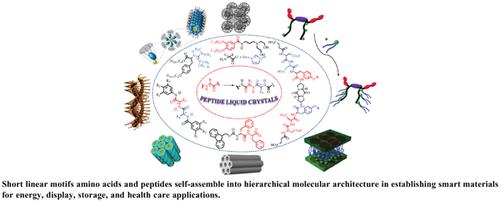Current Organic Synthesis ( IF 1.7 ) Pub Date : 2021-05-31 , DOI: 10.2174/1570179417666200916092109 Govindaswamy Shanker 1 , Bishwajit Paul 1 , Anjali Ganjiwale 2

|
The role of amino acids and peptides has found remarkable usage in both living systems and nonliving materials, which have enabled its utility by virtue of crafting molecular architectures through covalent bonds and non-covalent interactions. In material chemistry, the role of peptides in Liquid Crystals (LCs) is profound, especially in the rapid construction of supramolecular hierarchical networks. The importance of LCs for a variety of societal needs leads to the synthesis of innumerable LCs by conventional mesogenic strategy and nonconventional molecular design principles. For example, electronic appliances, including flat panel TV displays, electronic notebooks, digital cameras, domestic devices, use LCs as an integral component for such applications. In addition, LCs are useful in biological systems, including stem cell research, sensors for bacteria, virus, and proteins. These accomplishments are possible mostly due to the non-conventional molecular design principles for crafting LCs using smaller molecular motifs. The usage of amino acids and peptides in LCs facilitates many intrinsic characteristics, including side-chain diversity, chirality, directionality, reversibility, electro-optical, columnar axis, stimuli-responsive complex molecular architectures. The next essential criteria for any LCs design for useful applications are room temperature LC (RT-LC); therefore, the quest for such LCs system remains highly significant. Evidently, there are around half a million liquid crystalline molecules; only a handful of RTLCs has been found, as there is no simple, precise strategy or molecular design principles to obtain RT-LC systems. The smaller molecular motifs of amino acids and linear peptides as a structural part of mesogenic molecules led to many LC phases with properties, including lyotropic, thermotropic, and its applications in different realms. Therefore, this review serves as a compilation of Small Peptide-based LCs (SPLCs) exhibiting lyotropic and thermotropic phases with applications in the recent advancements.
中文翻译:

基于氨基酸和肽的液晶:概述
氨基酸和肽的作用在生命系统和非生命材料中都有显着的用途,这使得它能够通过共价键和非共价相互作用构建分子结构而发挥效用。在材料化学中,肽在液晶 (LC) 中的作用是深远的,尤其是在超分子分层网络的快速构建中。LC 对各种社会需求的重要性导致通过常规介晶策略和非常规分子设计原则合成了无数 LC。例如,电子设备,包括平板电视显示器、电子笔记本、数码相机、家用设备,都使用 LC 作为此类应用的一个组成部分。此外,LC 可用于生物系统,包括干细胞研究、细菌、病毒和蛋白质的传感器。这些成就之所以成为可能,主要归功于使用较小分子基序制作 LC 的非常规分子设计原则。LC 中氨基酸和肽的使用促进了许多内在特征,包括侧链多样性、手性、方向性、可逆性、光电、柱状轴、刺激响应的复杂分子结构。用于有用应用的任何 LC 设计的下一个基本标准是室温 LC (RT-LC);因此,对此类 LC 系统的探索仍然非常重要。显然,大约有 50 万个液晶分子;由于没有简单、精确的策略或分子设计原则来获得 RT-LC 系统,因此只发现了少数 RTLC。氨基酸和线性肽的较小分子基序作为介晶分子的结构部分导致了许多具有性质的 LC 相,包括溶致、热致及其在不同领域的应用。因此,本综述汇集了具有溶致相和热致相的小肽基液相色谱 (SPLC),并在最近的进展中应用。











































 京公网安备 11010802027423号
京公网安备 11010802027423号